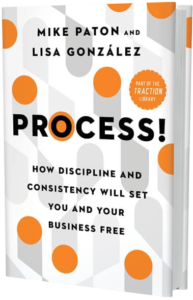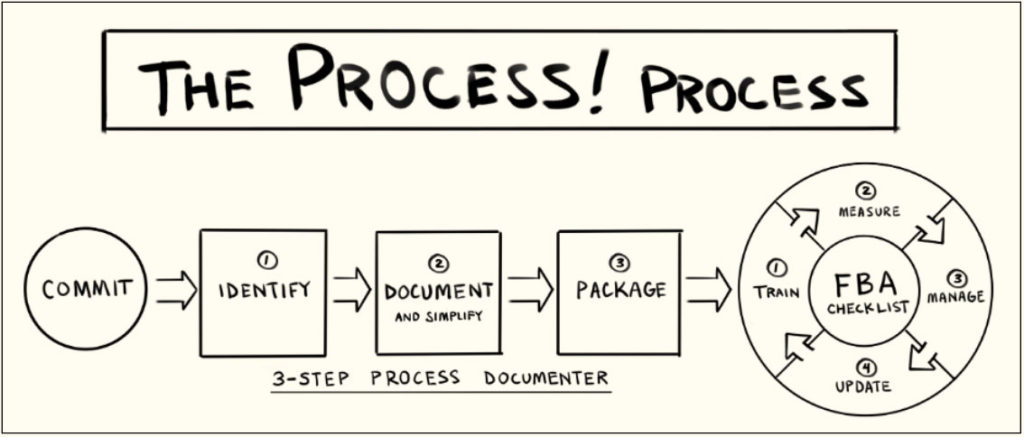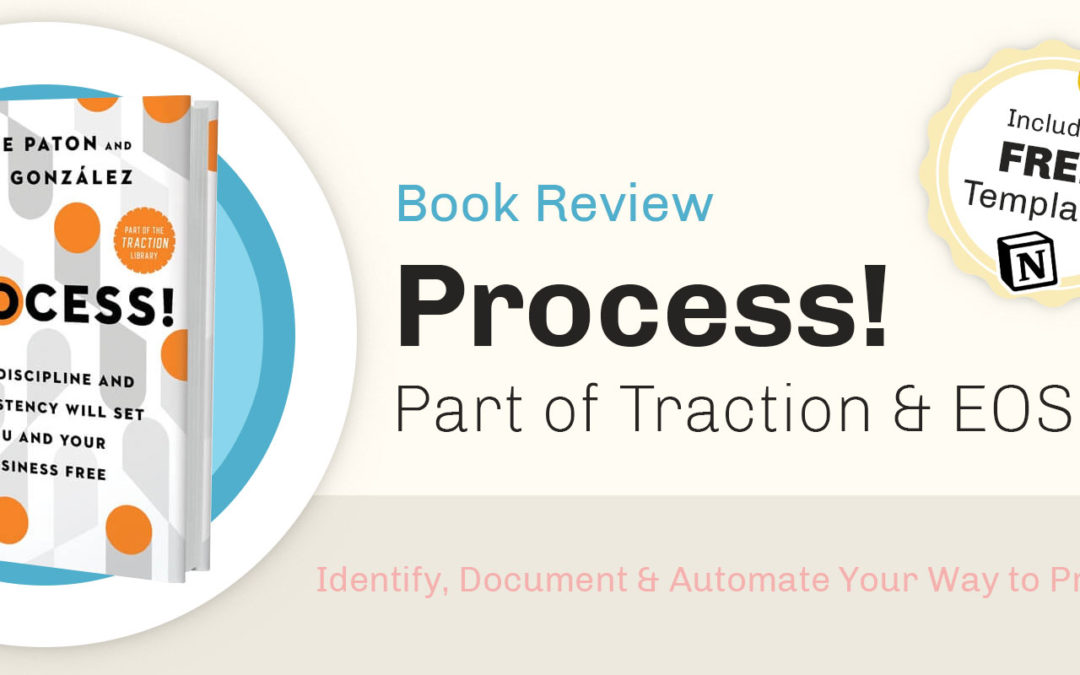NOTE: ScaleWell is in no way affiliated with EOS Worldwide. We’re simply a fan of the framework.
As someone who self-implemented, ran, and acted as Integrator of the Entrepreneurial Operating System (EOS) at my previous company, I was thrilled to learn there was an entire book dedicated to the part of business the ScaleWell focuses on: process.
Process is just one of the six key components of the system that keep companies aligned and doing their best work. As an operator, I naturally gravitate toward processes. I think in inputs and outputs, flow charts and org charts, and automated systems.
But for many people, process seems like the most daunting aspect of running a business: overly complex, restrictive, and cumbersome.
With a million things to do inside a business, who has time to build processes?
Download Process! Templates for Free
 Get a Head Start
Get a Head Start
We’ve translated the 3-Step Process Documenter into cloneable templates for you to use immediately. Start documenting your business’s Core Processes in minutes using example content.
First, what is EOS?
The Entrepreneurial Operating System (EOS) is a simple, yet comprehensive, business management system. It helps entrepreneurs and business leaders to better organize and manage their companies. It consists of a set of simple, practical tools and concepts that are designed to help businesses achieve their goals and objectives.
The Process section of EOS is one of the six key components that make up the system. Along with Vision, Data, Traction, Issues, and People, the Process component is focused on creating a set of clear, documented, and standardized processes that help businesses operate more efficiently and effectively.
To some (I’m looking at you, Visionaries), this may sound like a total snooze fest. To my fellow Integrators, the idea of documenting and standardizing processes probably gets you fired up.
EOS Process! Book Overview
Introduction & Setup


Understandably, the first few chapters focus on mindset and sell the reader on why process at a company is crucial (no need to convince me; I’ve long been drinking the Kool Aid).
The authors promote the benefits of building a process-driven culture and point out the real – and hidden – costs of having a weak process component.
Takeaway #1
Contrary to common belief, process frees up time and creates freedom. The phrase “Go slow to go fast” comes to mind here.
Yes, documenting processes and building automations does take time. But, they are better than the alternative: employees constantly running in different directions and doing things differently, over and over again in perpetuity.
Takeaway #2
Despite being a stickler for details myself and having the attention span necessary to parse through mundane minutiae of nearly any task, the part that resonated with me is that process isn’t an all or nothing proposition for business owners.
This should be music to the ears of Visionaries and employees alike.
Organizations don’t have to document and systematize every single micro-task each employee performs throughout the day. In fact, they shouldn’t.
Too much documentation leads to a manual or internal wiki that doesn’t get used.
Instead, Paton and Gonzalez recommend the 80/20 rule: companies should start by documenting the 20 percent of work that produces 80 percent of the results.
“Systemize the predictable, so you can humanize the exceptional.” – Isadore Sharp, founder of Four Seasons Hotel
Summary
The meat of the book starts in Section II: Learn.
As a visual thinker, The 3-Step Process Documenter diagram (below) made the concept more digestible. Each step is then broken out and expanded on in more detail later in the book.
We’ll cover the highlights below.


The authors note that it will take between nine months and a year for a typical leadership team to work through the above process. Yikes!
That is probably why they dedicate the first part of the book convincing the reader to commit to the process. Without buy-in from the entire leadership team, there is little chance a company will have the endurance to complete the exercise.
???? Note: ScaleWell offers a “done-with-you” service for the 3-Step documentation process and a “done-for-you” service to automate the parts of your processes that can be streamlined with technology. Learn More »
Step 1. Identify Core Processes
In this step, the goal is to identify and list all of the Core Processes that are crucial for the business’s operations. This is just a well-curated list, nothing more. These Core Processes are the essential activities that need to be performed consistently for the business to succeed.
In EOS parlance, if a Proven Process explains “What We Do” to outside parties, a Core Process is “How We Do It” for internal teams.
Most teams already carry their company’s (or department’s) Core Processes in their heads.
While many companies may have the same basic Core Processes (like Recruiting, Accounting, or Customer Success), it is helpful to identify the processes that make your organization truly unique.
- What do you do better than anyone else in your industry?
- What do you differently
- Why?
Capturing these five to twelve most important, repeatable processes are what you’re after. Spend an hour with leadership to debate options and get them down on paper to align the whole team on what the most important processes are.
This list will serve as a starting point for the documentation process.
They also act as a barrier that prevents teams from spending time documenting non-core processes.


Step 2. Document (and Simplify) the Processes
Once your Core Processes have been identified, the next step is to begin documenting them.
This involves writing down the steps involved in each process in a simple and clear manner. Documentation should be easy to understand and follow, ensuring that anyone in the organization can execute the process correctly and consistently.
2a. Start with the big picture. Capture the most important information first, then work to add in details as needed. Don’t get lost in the minutiae or capture unnecessary steps.
A basic outline will help capture the main steps. From there, you and your team can start filling in the gaps with more detailed instructions, screenshots, videos, and more.
Personally, I like to manually write steps down on Post-It Notes or a notepad to start. It allows me to easily add or rearrange items as I brainstorm ideas and think through my day-to-day.
2b. Next, you must decide who will be the one responsible for documenting your processes. If it’s you, it makes the task more clear cut. You can (and likely should) delegate the duty of filling in the details to someone else on your team.
ScaleWell encourages leaders to consult and collaborate with their teams, especially if those members are the ones running the processes day-to-day. But we also believe that there should be one person responsible for documenting the entire process from start to finish.
Step 3. Package
This final step of “Packaging” focuses on editing, organizing, and publishing the documentation of your Core Processes so they can be used by your teams.
The goal is to ensure that team members can easily find what they need and follow your newly documented processes to perform their jobs most effectively.
3a. Assuming that each Core Process clearly defines the steps necessary to reach a desired goal (“Close 10 New Sales per Month” or “Manufacture 20,000 Widgets”) and that your leadership team has reviewed and agrees with each, it’s time to hit Publish.
Selecting the right format, medium, or platform can be a project unto itself. In future blog posts, we will highlight the pros and cons of some of our favorite tools.
For now, we suggest the K.I.S.S. approach. Keep things simple and use tools that your team already has access to. For example, it doesn’t help to introduce new software if your company is already a Google Workspace shop.
3b. Once the content has been uploaded, make these processes easy to find. Here are a few ideas to make them sticky:
- Send an internal email announcing their new location
- Pin a Slack update with a link
- Star them in Google Drive
- Add a shortcut in your browser’s Bookmarks
- Open the URL each time a new browser tab is opened
Step 4. FBA Checklist: Implement and Refine
FBA stands for “Followed By All.” Adherence to a process ensures consistency and enables the automation of certain steps in the future.
After packaging and sharing your processes with the organization, the next step is to ensure everyone is following them. This involves training the team on the new processes and ensuring they are being updated on a consistent basis.
As the processes are used, there may be opportunities to refine and improve them. This step involves collecting feedback, analyzing the effectiveness of the processes, and making necessary adjustments to improve efficiency and effectiveness.
One of the benefits of packaging your Core Processes in online platforms (like Google Docs or Notion) is the ability to update them as often as needed. Even team (certain) members responsible for performing the processes could be given permission to click edit, make a change, and hit Save on their own.
Applying the Ideas
Like everything in business, the concepts in Process! are straight-forward and easy to grasp.
It’s the execution that’s the hard part.
It is easy to envision what is supposed to happen. Every business owner and manager wants their operation to run smoothly. It is fun to daydream about a set of perfectly crafted guidelines that make work more fun and efficient.
But few are willing to think deeply about their strategy, define what gives their organization power and scalability over the long-term, and take the time to build and document a replicable plan to achieve their goals.
This is the hard work that motivated entrepreneurs need to put in if they want to get something valuable back in the future.
Luckily, Process! lays out an easy-to-follow plan that you and your team could implement on your own.
Opportunities
The thesis behind ScaleWell is that certain business processes can be automated to free up employees to do higher value work.
That is why one sentence at the beginning of Chapter 7 struck me as, well, old-fashioned:
“After all, we assume you lead and manage people – not robots.” Process! (pg. 125)
While processes can – and should – be written in a way that humans can understand and use them, we also believe writing them solely for that purpose is limiting.
If a company assumes that labor (people) is the only way to scale, they are overlooking three additional resources.
Often, the only thing keeping many companies from fully automating parts of their businesses is imagination. Many simply don’t know what’s possible through code and, as a result, continue to throw bodies at the problem of scaling their business.
ScaleWell isn’t in the business of automating process in the physical world (yet), but in our eyes, the gap between a process created for a human to follow and one for robots to run is shrinking.
Today, a well-defined process may require total or partial human intervention. Tomorrow though, more and more well-crafted processes will be handled by code and run continuously, 24-hours a day, with zero interruption or errors.
What is code but a series of instructions that robots can read, follow, and execute on your company’s behalf?
Conclusion & Free Resources
Process! is a great how-to resource for companies already implementing the broader EOS framework, as well as those who aren’t.
Its practical advice, step-by-step framework, and simple thought exercises will undoubtedly help business operators build a future version of their company that is more aligned, efficient, replicable, and profitable.
Familiar Beginnings
A handful of early conversations have gone something like this:
- ScaleWell: “Alright, which process would you like to automate first?”
- Client: “Ummm, what do you mean by processes?”
- ScaleWell: “The things you do over and over again. How do your teams know what to do?”
- Client: “Well, they just sort of… do it.”
ScaleWell: “Do you have those steps written down anywhere?” - Client: “Not reeeaaallllyyy…..”
It reminded me of a story Nathan Barry told while building ConvertKit.
Some customers were signing up for his email service even though they didn’t have a website or way to collect email addresses.
His solution: Build a feature that enabled customers to build and launch their own landing pages inside ConvertKit (which allowed them to grow their email list without a website).
My lightbulb moment: Businesses want to automate processes… but very few have them documented.
Solution
We’ve turned the concepts from this book into FREE downloadable templates to help you put the horse before your cart.
If you know what your employees do but haven’t taken the time to document them yet, here is your chance.
Download the Process! Templates for Free



We’ve translated the 3-Step Process Documenter into cloneable templates for you to use immediately. Start documenting your business’s Core Processes in minutes using example content.
The 3-Step Process Documenter templates (available as Google Docs and Notion) contain a sample outline, placeholder pages and contents that you can use, edit, move, or delete to get started on your documentation journey.
Best of all, if your company already uses Google Docs or Notion already, your company’s process will be ready to share with your team once you add a little polish (see Step 3 above).
Don’t use Google Workspace or Notion? No problem.
Simply copy and paste the contents into the platform of your choice and modify to your heart’s content.
Share Your Thoughts
As part of our own feedback look and improvement process, we’d love to hear what you think.
- How was this book summary?
- How is the template?
- Is there anything else you want us to cover in the future?


AWESOME summary. Beautifully created with great, easy to understand visuals and clearly written descriptions of your takeaways. Excited to jump into the templates and see how usable the material is!
Thanks, Dakota. Appreciate the feedback. Can’t wait to hear what you think of the templates. Keep me (and everyone) posted.